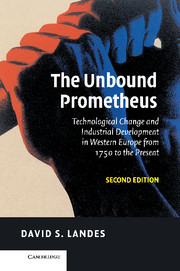 The Unbound Prometheus
The Unbound Prometheus Preface to the new edition
Published online by Cambridge University Press: 05 June 2014
Summary
‘Revolution’ is a potently ambivalent word. In one sense, it means a turning, a deep change. In another, it means a quick change, typically political in character. Both meanings are strong enough to elicit sentiments, often keen sentiments, of approval or disapproval. Not everyone likes change, but those who want the world to be different often yearn for it.
The notion of an Industrial Revolution—deep transformation of the mode of production—goes back a couple of centuries, almost as far as the first appearance of those techniques that constituted the transformation. Adam Smith already alluded to the link between new ways and new riches, between new ways and international competition, in The Wealth of Nations, published in the great year of 1776. This new technology entailed not only the making and use of productive tools and machines, inventions and innovations, but new modes of labour organization and concentration, sometimes summed up in the term ‘factory system’. And these gave rise in turn to a literature of criticism and protest on behalf of the working population (alias working classes), most prominently tied to Karl Marx and Friedrich Engels in the fourth and fifth decades of the nineteenth century. These anti-capitalist writings have continued to influence thought and judgment, partly because of their link to still viable political action, partly because of moral and ethical resentment and repudiation of the new forms of wealth that have emerged from modern industry and its economic consequences.
Information
- Type
- Chapter
- Information
- The Unbound PrometheusTechnological Change and Industrial Development in Western Europe from 1750 to the Present, pp. x - xiiPublisher: Cambridge University PressPrint publication year: 2003